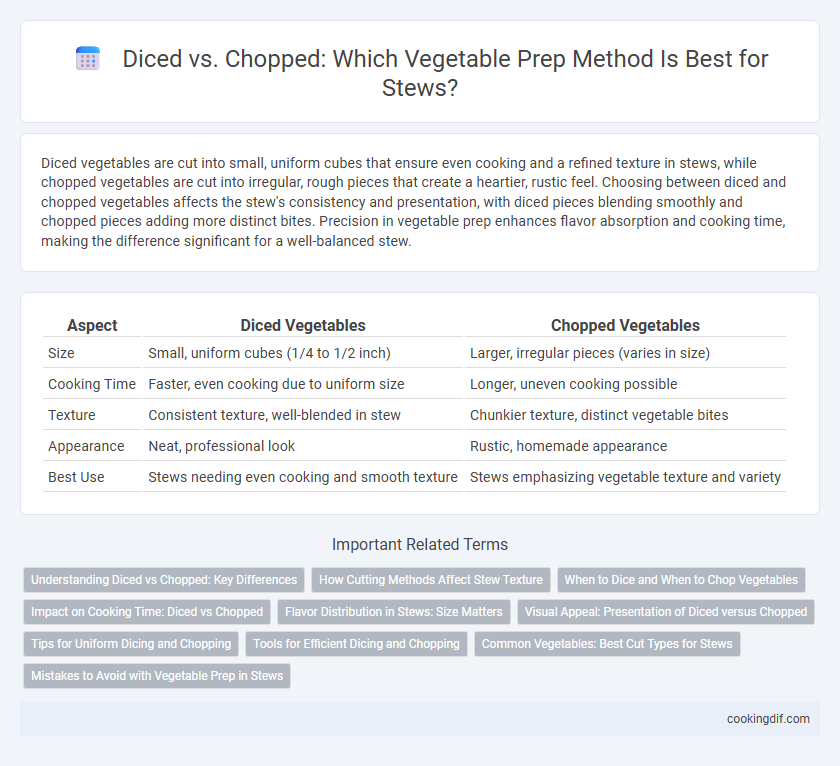Diced vegetables are cut into small, uniform cubes that ensure even cooking and a refined texture in stews, while chopped vegetables are cut into irregular, rough pieces that create a heartier, rustic feel. Choosing between diced and chopped vegetables affects the stew's consistency and presentation, with diced pieces blending smoothly and chopped pieces adding more distinct bites. Precision in vegetable prep enhances flavor absorption and cooking time, making the difference significant for a well-balanced stew.
Table of Comparison
| Aspect | Diced Vegetables | Chopped Vegetables |
|---|---|---|
| Size | Small, uniform cubes (1/4 to 1/2 inch) | Larger, irregular pieces (varies in size) |
| Cooking Time | Faster, even cooking due to uniform size | Longer, uneven cooking possible |
| Texture | Consistent texture, well-blended in stew | Chunkier texture, distinct vegetable bites |
| Appearance | Neat, professional look | Rustic, homemade appearance |
| Best Use | Stews needing even cooking and smooth texture | Stews emphasizing vegetable texture and variety |
Understanding Diced vs Chopped: Key Differences
Diced vegetables are cut into small, uniform cubes usually measuring around 1/4 inch, ensuring even cooking and a consistent texture in stews. Chopped vegetables vary in size and shape, offering a rustic appearance that can alter the stew's texture and cooking time. Understanding the size and uniformity distinction between diced and chopped vegetables is crucial for achieving the desired stew consistency and flavor balance.
How Cutting Methods Affect Stew Texture
Diced vegetables create a uniform texture and cook evenly in stew, allowing flavors to meld smoothly without overpowering each bite. Chopped vegetables offer a more rustic texture with varied sizes, adding visual interest and a heartier bite to the stew. The choice between diced and chopped impacts not only cooking time but also the overall mouthfeel and presentation of the stew.
When to Dice and When to Chop Vegetables
Dicing vegetables involves cutting them into small, uniform cubes, ideal for recipes like stews where even cooking and consistent texture are important. Chopping produces larger, irregular pieces that work best when a rustic texture or quicker preparation is desired, such as in chunky vegetable stews. Use dicing for precise cooking times and presentation, while chopping suits hearty dishes requiring less uniformity.
Impact on Cooking Time: Diced vs Chopped
Diced vegetables cook faster than chopped ones due to their smaller, uniform size, allowing heat to penetrate evenly and quickly. Chopped vegetables, being larger and irregular, require longer cooking times to become tender and fully integrate flavors in stews. Choosing diced vegetables enhances recipe efficiency, reducing overall cooking time without compromising texture.
Flavor Distribution in Stews: Size Matters
Diced vegetables create uniform pieces that cook evenly, enhancing consistent flavor distribution throughout the stew. Chopped vegetables vary in size, resulting in uneven cooking and pockets of stronger or milder flavors. Choosing the right size directly impacts the stew's taste balance and texture harmony.
Visual Appeal: Presentation of Diced versus Chopped
Diced vegetables offer a uniform, precise appearance that enhances the visual appeal of a stew by creating a consistent texture and even cooking. Chopped vegetables provide a more rustic, varied look with irregular shapes that add a hearty, natural charm to the dish. Both methods influence presentation, with diced vegetables lending a polished finish and chopped vegetables delivering a homestyle, casual aesthetic.
Tips for Uniform Dicing and Chopping
Achieving uniform dicing and chopping in stew preparation ensures even cooking and enhances the stew's texture and visual appeal. Use a sharp chef's knife and a stable cutting board while maintaining consistent vegetable sizes by measuring with the knife edge as a guide. Practice proper knife techniques such as the claw grip to maintain control and safety, enabling precise, consistent cuts that elevate the overall quality of the stew.
Tools for Efficient Dicing and Chopping
Efficient dicing and chopping for stew preparation rely on using sharp, high-quality knives such as chef's knives or Santoku knives to ensure precision and uniformity. A stable cutting board with a non-slip surface enhances safety and control while utensils like vegetable choppers or food processors can accelerate the process. Consistent size and shape of diced or chopped vegetables improve cooking evenness and texture in stews.
Common Vegetables: Best Cut Types for Stews
Carrots and onions are best diced for stews to ensure even cooking and a consistent texture that integrates well into the broth. Potatoes benefit from being chopped into larger, uniform pieces to maintain their shape and provide a hearty bite without disintegrating during long simmering. Celery is ideal when diced finely to release its flavor uniformly, enhancing the overall stew without overpowering other ingredients.
Mistakes to Avoid with Vegetable Prep in Stews
Avoid cutting vegetables inconsistently in stews, as uneven sizes cause uneven cooking and texture issues. Diced vegetables ensure uniform cooking and better flavor distribution, while chopped vegetables may vary too much in size. Overcrowding the pot with large chunks or irregular pieces can result in undercooked vegetables and a less balanced stew.
Diced vs Chopped for vegetable prep Infographic

 cookingdif.com
cookingdif.com